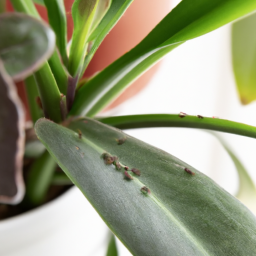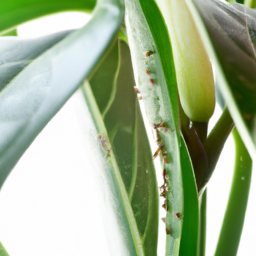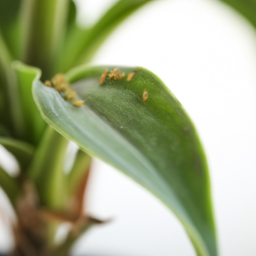
Have you ever wondered, “How do indoor plants get aphids?” It’s a question that many plant enthusiasts find themselves asking when they discover these tiny, pesky insects infesting their beloved greenery. Indoor plants can be a haven for aphids, those minuscule pests that seem to appear out of nowhere and wreak havoc on our leafy companions. In this blog post, we’ll explore the various ways indoor plants become susceptible to aphid infestations, and how you can prevent and treat them to keep your plants healthy and thriving. So, let’s dive in and uncover the secrets behind how indoor plants end up with these unwanted visitors!
Prevention and Control Measures for Aphids on Indoor Plants
Aphids, those tiny insects that can wreak havoc on your indoor plants, are a common problem for many plant enthusiasts. These pesky creatures feed on the sap of plants, causing damage to leaves, stems, and flowers. To ensure the health and vitality of your indoor plants, it is crucial to understand how aphids infest indoor plants and implement effective prevention and control measures. In this article, we will explore the step-by-step guide on how indoor plants get aphids and provide you with practical solutions to keep these pests at bay.
Understanding How Indoor Plants Get Aphids
Aphids can find their way into your indoor plants through various means. Here are some common ways they infest your green companions:
1. Infested Plants: Bringing infested plants into your indoor garden is one of the primary ways aphids invade your space. These pests can hitch a ride on new plants or even on items like gardening tools, pots, or soil. Therefore, it is essential to thoroughly inspect any new additions to your collection before introducing them to your indoor environment.
2. Open Windows and Doors: Aphids are excellent flyers, and if you leave your windows or doors open, they can easily make their way inside. They are attracted to the scent of plants and will follow it to find a suitable host. To prevent this, consider installing screens on your windows and doors or use mesh netting to keep them out.
3. Contaminated Clothing or Pets: Believe it or not, aphids can also hitch a ride on your clothing or your furry friends. If you have been working in an outdoor garden infested with aphids, they might cling to your clothes or your pet’s fur. Make sure to change your clothes and thoroughly inspect your pets before entering your indoor plant area.
Prevention Measures
Now that we understand how aphids can infiltrate our indoor plant haven, let’s explore some preventive measures to keep them away:
1. Quarantine New Plants: Whenever you bring a new plant home, it is crucial to isolate it from your existing plants for a few weeks. This quarantine period allows you to closely monitor the plant for any signs of aphids or other pests. If you notice any infestation, take immediate action to prevent the pests from spreading to other plants.
2. Regularly Inspect Plants: Conduct routine inspections of your indoor plants to catch any signs of aphids early on. Look for sticky residue, distorted leaves, or the presence of ants, as they often farm aphids for their honeydew. Promptly remove any affected leaves or stems and take appropriate action to eliminate the aphids.
3. Maintain a Clean Environment: Aphids are attracted to dirty and dusty environments. Regularly clean your indoor plant area, including the pots, trays, and surrounding surfaces. This helps to remove any potential hiding spots and reduces the risk of aphid infestations.
Control Measures
If despite your best efforts, aphids manage to invade your indoor plants, here are some effective control measures:
1. Natural Remedies: There are several natural remedies you can use to combat aphids. These include spraying your plants with a mixture of water and mild dish soap, using neem oil, or introducing beneficial insects like ladybugs or lacewings that feed on aphids. These methods are safe for your plants and environment-friendly.
2. Chemical Insecticides: If the infestation becomes severe and natural remedies fail to provide adequate control, you may consider using chemical insecticides. However, exercise caution when using these products, as they can be harmful to humans, pets, and beneficial insects. Always follow the instructions carefully and use them as a last resort.
3. Pruning and Trimming: If the aphid infestation is localized to specific parts of your indoor plants, pruning and trimming affected leaves or stems can help control the spread. Dispose of the pruned material properly to prevent reinfestation.
Remember, prevention is always better than cure when it comes to aphids on indoor plants. By implementing these preventive measures and promptly addressing any signs of infestation, you can ensure the health and beauty of your indoor plant collection. Happy gardening!

Identifying Aphid Infestations on Indoor Plants: Signs and Symptoms
Indoor plants bring life and beauty to our homes, but they can also attract unwanted guests like aphids. These tiny, soft-bodied insects are a common pest for indoor plants and can quickly multiply if left untreated. In this guide, we will explore the signs and symptoms of aphid infestations on indoor plants, helping you identify and tackle these pesky invaders.
1. Sticky Residue and Black Sooty Mold
One of the first signs of an aphid infestation is the presence of sticky residue on your indoor plant’s leaves, stems, and surrounding surfaces. This sticky substance, known as honeydew, is a result of aphids feeding on the plant’s sap. As aphids consume sap, they excrete excess sugars, which form this sticky residue. If you notice a shiny or sticky film on your plant or nearby furniture, it is likely a sign of aphids.
Moreover, the honeydew produced by aphids can attract another nuisance: black sooty mold. This mold grows on the honeydew, forming a black, powdery coating on the plant’s surface. If you spot this black sooty mold on your indoor plant, it is a clear indication of an aphid infestation.
To confirm the presence of aphids, inspect the affected plant closely. Look for small, pear-shaped insects ranging in color from green to brown or even black. Aphids have soft bodies and can be as small as a pinhead or as long as 1/8 inch. They often cluster together on new growth, undersides of leaves, or near flower buds.
2. Distorted or Curling Leaves
Aphids have a voracious appetite for plant sap, and their feeding can cause visible damage to indoor plants. If you notice leaves on your plant becoming distorted, curling, or puckering, it may be a sign of an aphid infestation. As aphids extract sap from the plant, they inject toxic saliva, which can cause the leaves to deform and curl.
Inspect the undersides of affected leaves for aphid colonies or eggs. These pests often prefer concealed spots, so make sure to thoroughly examine the plant. If you find clusters of aphids or tiny white or yellow eggs, it confirms the presence of an infestation.
Additionally, aphids can cause stunted growth in indoor plants. If you observe your plant failing to thrive or displaying reduced growth, it is worth investigating for aphids.
3. Yellowing or Wilting Plants
Another sign of an aphid infestation is the yellowing or wilting of leaves on your indoor plant. Aphids feed on the plant’s sap, depriving it of vital nutrients. This can lead to a lack of chlorophyll production, resulting in yellowing or browning of leaves. If your plant exhibits these symptoms, it is essential to inspect it for aphids.
Furthermore, aphids can transmit plant viruses, which can cause additional damage to your indoor plants. If you notice any unusual patterns of wilting, yellowing, or discoloration, it is crucial to investigate for aphids promptly.
Now that you are equipped with the knowledge of identifying aphid infestations on indoor plants, you can take the necessary steps to control and eliminate these pests. Remember to regularly inspect your plants for signs of aphids, and if you spot an infestation, act quickly to prevent further damage.
There are various methods to control aphids, including natural remedies like spraying plants with a mixture of water and mild soap or using insecticidal soaps specifically designed for aphid control. In severe cases, you may need to resort to chemical insecticides, but always follow the instructions carefully and consider the potential impact on beneficial insects.
By staying vigilant and taking proactive measures, you can keep your indoor plants healthy and free from aphid infestations. Happy gardening!

Natural Remedies to Get Rid of Aphids on Indoor Plants
Introduction
Indoor plants are a great way to bring nature into your home. They not only add beauty to your living space but also provide numerous health benefits. However, just like outdoor plants, indoor plants are susceptible to pests, including aphids. These tiny insects can quickly multiply and infest your beloved indoor plants if not addressed promptly. In this guide, we will explore how indoor plants get aphids and provide you with effective natural remedies to get rid of them.
Understanding How Indoor Plants Get Aphids
Aphids are small sap-sucking insects that feed on the fluids of plants. They are attracted to indoor plants for various reasons, including:
1. Lack of air circulation: Indoor environments often have limited air circulation, creating an ideal breeding ground for aphids. Stagnant air allows them to thrive and reproduce rapidly.
2. Infected plants: Bringing new plants into your home without proper inspection can introduce aphids to your indoor garden. These pests may already be present on the new plant or in the soil it comes with.
3. Contaminated gardening tools: If you use gardening tools that have been previously exposed to aphid-infested plants, you risk transferring the pests to your indoor plants. It is crucial to clean and sanitize your tools regularly to prevent such infestations.
Natural Remedies to Get Rid of Aphids on Indoor Plants
1. Manual Removal
One of the simplest and most effective ways to control aphids on indoor plants is by manually removing them. Here’s how to do it:
– Gently wipe the affected leaves and stems with a soft cloth or sponge soaked in a mild soapy water solution.
– Pay close attention to the undersides of leaves, as aphids tend to hide there.
– Repeat this process daily until the infestation is under control.
– Remember to dispose of the captured aphids properly to prevent reinfestation.
2. Homemade Insecticidal Soap
Insecticidal soaps are an excellent natural remedy for aphids on indoor plants. You can easily make your own at home with the following steps:
– In a spray bottle, mix 1 tablespoon of mild liquid soap (such as castile soap) with 1 quart of water.
– Shake the bottle gently to ensure the soap is well-dissolved.
– Spray the solution directly onto the affected plants, covering both the upper and lower surfaces of the leaves.
– Leave the solution on the plants for a few hours, then rinse it off with clean water.
– Repeat this process every few days until the aphids are eliminated.
3. Neem Oil
Neem oil is a natural insecticide derived from the neem tree. It is highly effective against aphids and other common indoor plant pests. Here’s how to use neem oil to get rid of aphids:
– Dilute neem oil according to the instructions on the product label.
– Fill a spray bottle with the diluted neem oil solution.
– Spray the solution onto the affected plants, ensuring thorough coverage.
– Leave the solution on the plants for a few hours, then rinse it off with clean water.
– Repeat this process every 7-10 days until the aphids are eradicated.
4. Beneficial Insects
Introducing beneficial insects to your indoor garden can help control aphid populations naturally. Ladybugs and lacewings are two common beneficial insects that prey on aphids. Here’s how to attract them:
– Purchase ladybugs or lacewings from a reputable supplier.
– Release them near the affected plants in the evening, as they are most active during the night.
– Provide a water source, such as a shallow dish with water and pebbles, to encourage them to stay in your indoor garden.
– Repeat the process if necessary, as some beneficial insects may fly away after a few days.
Conclusion
Aphids can be a nuisance for indoor plant enthusiasts, but with the right knowledge and natural remedies, you can effectively eliminate them. Remember to regularly inspect your plants, maintain proper air circulation, and sanitize your gardening tools. Manual removal, homemade insecticidal soap, neem oil, and beneficial insects are all effective methods to control and get rid of aphids on your indoor plants. By employing these natural remedies, you can enjoy a thriving and pest-free indoor garden.
Crisp Recap
Indoor plants are a great way to bring a touch of nature into your home, but they can also attract unwanted guests: aphids. These tiny insects are notorious for munching on the leaves and stems of plants, causing damage and stunting their growth. But how do these pesky critters find their way indoors in the first place?
One common way aphids make their way into your home is through open windows or doors. They can be carried in on a gentle breeze or even hitch a ride on your clothing. Once inside, they quickly find their way to your beloved indoor plants, where they feast on the sap within the leaves. Another way aphids can infest your indoor plants is through contaminated soil or new plants you bring home. If the soil or plant is already infested with aphids, they can easily spread to other plants in your collection. Additionally, aphids can be brought in on cut flowers or even on the backs of other insects, so it’s important to thoroughly inspect any new additions to your indoor garden.
Frequently Asked Questions from our readers:
Q1: How do indoor plants get aphids?
A1: Indoor plants can get aphids through various means. One common way is through infested plants that are brought indoors. Aphids can hitch a ride on new plants or cuttings, entering your home and infesting your indoor plants. Additionally, aphids can also be carried indoors by pets or on clothing if they have been in contact with infested outdoor plants.
Q2: What attracts aphids to indoor plants?
A2: Aphids are attracted to indoor plants for several reasons. They are drawn to the sap of plants, which provides them with a source of food. They are also attracted to the tender, new growth of plants, as it is easier for them to feed on. Furthermore, aphids are attracted to plants that have a high nitrogen content, as this nutrient promotes lush growth, which aphids find appealing.
Q3: Can overwatering indoor plants lead to aphid infestations?
A3: Overwatering indoor plants can create a favorable environment for aphids, but it does not directly cause infestations. Aphids thrive in humid conditions, and overwatering can increase the moisture levels around plants, creating a humid environment that aphids are attracted to. Therefore, it is important to strike a balance in watering indoor plants to prevent excess moisture and reduce the risk of aphid infestations.
Q4: How can I prevent aphids from infesting my indoor plants?
A4: To prevent aphids from infesting your indoor plants, there are several steps you can take. Firstly, regularly inspect new plants or cuttings before bringing them indoors to ensure they are aphid-free. Secondly, keep your indoor plants healthy by providing them with proper care, including adequate sunlight, appropriate watering, and regular fertilization. Strong, healthy plants are less likely to attract aphids. Additionally, maintaining good airflow around your plants and periodically cleaning their leaves can help deter aphids.
Q5: What are some natural remedies to get rid of aphids on indoor plants?
A5: There are several natural remedies you can try to get rid of aphids on indoor plants. One option is to use a mixture of water and mild dish soap. Dilute a few drops of dish soap in water and spray it on the affected plants, focusing on the undersides of leaves where aphids tend to hide. Another natural remedy is neem oil, which can be mixed with water and sprayed on the plants. Additionally, introducing beneficial insects like ladybugs or lacewings can help control aphid populations.

James Wong is a renowned ethnobotanist, plant scientist, and local television presenter. With a passion for demystifying plant science, he is known for translating complex botanical concepts into practical advice for everyday plant enthusiasts. James’s expertise spans from traditional gardening to cutting-edge plant technologies, making his insights accessible and informative.


